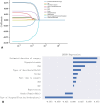An explainable and supervised machine learning model for prediction of red blood cell transfusion in patients during hip fracture surgery
- PMID: 39702008
- PMCID: PMC11656766
- DOI: 10.1186/s12871-024-02832-y
An explainable and supervised machine learning model for prediction of red blood cell transfusion in patients during hip fracture surgery
Abstract
Aim: The study aimed to develop a predictive model with machine learning (ML) algorithm, to predict and manage the need for red blood cell (RBC) transfusion during hip fracture surgery.
Methods: Data of 2785 cases that underwent hip fracture surgery from April 2016 to May 2022 were collected, covering demographics, medical history and comorbidities, type of surgery and preoperative laboratory results. The primary outcome was the intraoperative RBC transfusion. The predicting performance of six algorithms were respectively evaluated with the area under the receiver operating characteristic (AUROC). The SHapley Additive exPlanations (SHAP) package was applied to interpret the Random Forest (RF) model. Data from 122 patients at The Third Affiliated Hospital of Sun Yat-sen University were collected for external validation.
Results: 1417 patients (50.88%) were diagnosed with preoperative anemia (POA) and 209 patients (7.5%) received intraoperative RBC transfusion. Longer estimated duration of surgery, POA, older age, hypoproteinemia, and surgery of internal fixation were revealed as the top 5 important variables contributing to intraoperative RBC transfusion. Among the six ML models, the RF model performed the best, which achieved the highest AUC (0.887, CI 0.838 to 0.926) in the internal validation set. Further, it achieved a comparable AUC of 0.834(0.75, 0.911) in the external validation set.
Conclusion: Our study firstly demonstrated that the RF model with 10 common variables might predict intraoperative RBC transfusion in hip fracture patients.
Keywords: Hip fracture; Machine learning; Predictive model; Red blood cell transfusion; SHapley Additive exPlanations.
© 2024. The Author(s).
Conflict of interest statement
Declarations. Ethics approval and consent to participate: The present study was a retrospective study, which did not interfere with hip fracture surgeries in any way. All of the clinical judgments were made by clinicians for medical reasons. No written consent was required in view of the purely observational nature of the study. No identifiable data of the patients were recorded during the whole study. The study was approved by the ethics committee of Guangdong Provincial Hospital of Chinese Medicine ((No. ZE2023-201–01). Consent for publication: Not applicable. Competing interests: The authors declare no competing interests.
Figures






Similar articles
-
Application of machine learning model in predicting the likelihood of blood transfusion after hip fracture surgery.Aging Clin Exp Res. 2023 Nov;35(11):2643-2656. doi: 10.1007/s40520-023-02550-4. Epub 2023 Sep 21. Aging Clin Exp Res. 2023. PMID: 37733228 Clinical Trial.
-
Development of machine learning models to predict perioperative blood transfusion in hip surgery.BMC Med Inform Decis Mak. 2024 Jun 5;24(1):158. doi: 10.1186/s12911-024-02555-7. BMC Med Inform Decis Mak. 2024. PMID: 38840126 Free PMC article.
-
Development and validation of machine learning models to predict perioperative transfusion risk for hip fractures in the elderly.Ann Med. 2024 Dec;56(1):2357225. doi: 10.1080/07853890.2024.2357225. Epub 2024 Jun 20. Ann Med. 2024. PMID: 38902847 Free PMC article.
-
Machine Learning for the Prediction of Red Blood Cell Transfusion in Patients During or After Liver Transplantation Surgery.Front Med (Lausanne). 2021 Feb 22;8:632210. doi: 10.3389/fmed.2021.632210. eCollection 2021. Front Med (Lausanne). 2021. PMID: 33693019 Free PMC article.
-
Interventions for reducing red blood cell transfusion in adults undergoing hip fracture surgery: an overview of systematic reviews.Cochrane Database Syst Rev. 2023 Jun 8;6(6):CD013737. doi: 10.1002/14651858.CD013737.pub2. Cochrane Database Syst Rev. 2023. PMID: 37294864 Free PMC article. Review.
References
-
- Johnell O, Kanis JA. An estimate of the worldwide prevalence and disability associated with osteoporotic fractures. Osteoporos Int. 2006;17(12):1726–33. - PubMed
-
- Gruson KI, Aharonoff GB, Egol KA, Zuckerman JD, Koval KJ. The relationship between admission hemoglobin level and outcome after hip fracture. J Orthop Trauma. 2002;16(1):39–44. - PubMed
-
- Palm H, Hip Fracture: The choice of surgery. In: Falaschi P, Marsh D, editors. Orthogeriatrics: the management of older patients with fragility fractures. Cham (CH): Springer Copyright 2021, The Author(s); 2021. p. 125–41. - PubMed
-
- Bierbaum BE, Callaghan JJ, Galante JO, Rubash HE, Tooms RE, Welch RB. An analysis of blood management in patients having a total hip or knee arthroplasty. J Bone Joint Surg Am. 1999;81(1):2–10. - PubMed
-
- Spahn DJA. Anemia and patient blood management in hip and knee surgery: a systematic review of the literature. 2010;113(2):482–95. - PubMed
MeSH terms
LinkOut - more resources
Full Text Sources
Medical
Miscellaneous

